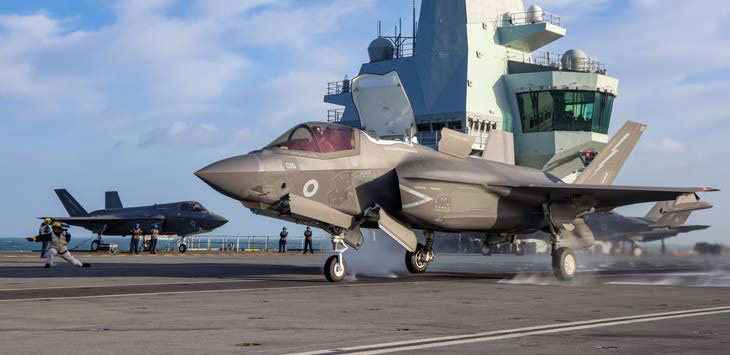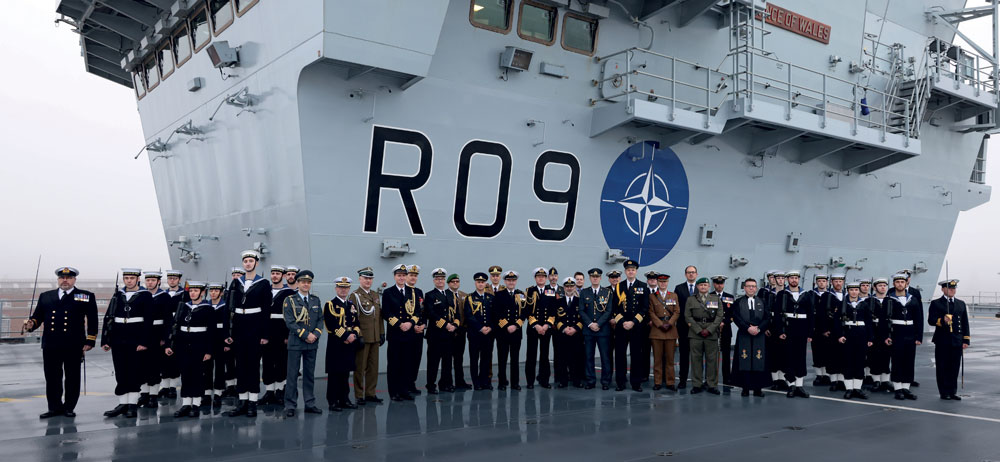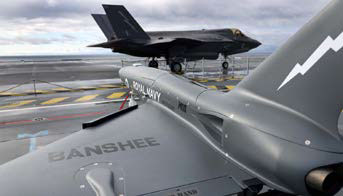DEFENCE CSG21 and beyond
UK carrier aviation – the next steps
RICHARD GARDNER reports on lessons from the inaugural deployment of the Royal Navy’s supercarrier HMS Queen Elizabeth in Asia-Pacific and the future of UK air power at sea.
 F-35s on board the HMS Queen Elizabeth. Royal Navy
F-35s on board the HMS Queen Elizabeth. Royal Navy
The homecoming of HMS Queen Elizabeth to its Portsmouth base at the end of 2021 marked the end of a pioneering seven month taskforce deployment to the Asia-Pacific region. Led by the first of the Royal Navy’s new-generation aircraft carriers, the nine ships and a nuclear submarine in United Kingdom Carrier Strike Group 21 (CSG21) collectively travelled over 500,000nm via the Mediterranean, the Middle East, Indian Ocean and South China Sea, to the Pacific. It visited or worked with 42 nations and took part in 18 major exercises and reaffirmed the UK’s revived military commitment to the Asia-Pacific.
This operational journey provided the first real test of the combined RN/RAF/USMC Air Wing aboard the 65,000t ship, and its jet aircraft completed 3,000 deck landings, of which 1,000 were at night. Along the way, the two embarked UK and US F-35B squadrons completed 1,278 sorties and flew more than 2,200hr. Some 44 combat missions were conducted in support of counter- Daesh missions over Iraq, as well as intercepts of inquisitive Russian aircraft based in Syria.
Later, in the South China Sea, the ship was subject to close interest from shadowing Chinese ships and aircraft and a high level of air missions were flown over 24hr periods demonstrating the Air Wing’s ability to provide persistent air cover and integrated data sharing with surface and underwater force assets. Air refuelling from US Navy F/A-18s was carried out and the carrier’s Air Wing flew a total of 4,723hr, with 1,290 at night, and exercised with 64 different aircraft types from 17 nations.
A unique feature of this deployment was the ability to conduct joint operations and exchanges with many other F-35 operators, including those already flying with or awaiting delivery of aircraft, including the Italian, Israeli, Japanese and Singapore armed forces. The UK, US and Australia are already well into developing their operational F-35 fleets but there was much regional interest from other naval observers seeing first-hand how the F-35B models can operate alongside helicopters from small carriers to give increased tasking flexibility.
 HMS Prince of Wales is now the NATO Maritime High Readiness Force Command Ship. Royal Navy
HMS Prince of Wales is now the NATO Maritime High Readiness Force Command Ship. Royal Navy
While in the Pacific, HMS Queen Elizabeth’s embarked US Marine Corps squadron of F-35Bs, VMFA-211, conducted take-off, refuelling and landing exercises with the USS America and USS Carl Vinson. The combined UK and US F-35B and F-35C Air Wings from the three carriers represented the biggest fifth-generation naval combat air gathering in the Pacific region to date.
Invaluable experience was gained in sortie generation and mission and maintenance sustainment. The integration of the advanced on-board digital systems on the F-35Bs and ship systems, as well as secure communications and cyber resilience, is a complex task but the close co-operation between the UK and US teams aboard the UK carrier provided a solid baseline to further develop new systems and capabilities in the future.
The advanced design of the new UK aircraft carriers was much admired by US and allied naval air operators, especially in the automated systems that allow rapid sortie turn-rounds with significantly reduced crew numbers. The sophisticated aircraft and deck control and information arrangements represent a step-change in flight deck design. Additionally, the unique performance of the F-35B allows safe all-weather day and night operations, including a feature usually denied to other fixed-wing carrier jets – flying when the vessel is engaged in ship-to-ship fuel and stores replenishment at sea. During CSG21 the carrier also deployed operationally for the first time the Merlin HM2 helicopters fitted with Crowsnest airborne early warning and control radar, and the smaller Wildcat HMA2, which can carry the new Thales Martlet lightweight air-to-surface missiles.
With HMS Queen Elizabeth now back in home waters, the operational RN focus has switched to the second new UK aircraft carrier, HMS Prince of Wales. On 11 January the author was on board to witness a ceremony, marking the ship’s new commitment for the next 12 months, as the NATO Command Ship (Flagship) with the task of leading the alliance’s Maritime High Readiness Force, an international task group formed to deal with major global events.
The most senior sea-going staff in the Royal Navy, Commander UK Strike Force, headed by Rear Admiral Mike Utley, has taken charge of the force, ready to deploy in support of NATO exercises and operations throughout the year. As well as a test of the battle staff, it will be the first test of HMS Prince of Wales since the carrier was declared fully operational at the beginning of last autumn. This year it will spend over 200 days at sea, starting by leading naval involvement in Cold Response 22, a large-scale Norwegian led NATO exercise, now under way.
 HMS Prince of Wales has tested operating jet-powered drones from its deck – a vision of a future carrier air wing? Royal NavyThe lessons from CSG21 are paving the way towards longer-term plans to broaden how the full capabilities of the carriers are exploited. The planned lifetime of the two carriers is 50+ years and clearly much will change in terms of what new technologies and capabilities will be needed. Already the Royal Navy and UK MoD is investigating how uncrewed air systems might be integrated into a Carrier Air Wing to augment crewed aircraft and that might offer a practical and affordable solution to increasing combat strength, as well as providing new platforms that enhance operational flexibility.
HMS Prince of Wales has tested operating jet-powered drones from its deck – a vision of a future carrier air wing? Royal NavyThe lessons from CSG21 are paving the way towards longer-term plans to broaden how the full capabilities of the carriers are exploited. The planned lifetime of the two carriers is 50+ years and clearly much will change in terms of what new technologies and capabilities will be needed. Already the Royal Navy and UK MoD is investigating how uncrewed air systems might be integrated into a Carrier Air Wing to augment crewed aircraft and that might offer a practical and affordable solution to increasing combat strength, as well as providing new platforms that enhance operational flexibility.
The MoD’s LANCA Mosquito ‘Loyal Wingman’ concept might have a naval carrier application but its early days in the scope of the Vixen and Vampire studies now being considered as part of the Future Maritime Aviation Force (FMAF) project. This is aimed at recognising areas where more attention is needed, including fixed-wing airborne early warning, naval sustainment air lift and persistent ISR. HMS Prince of Wales has already trialled the use of Jet Banshee target aircraft as part of a threat simulation exercise and this may lead to adoption as the launchers and vehicles require little deck-space.
CSG21 provided the initial operational deployment for the Merlin/Crowsnest helicopter/ radar combo, and medium-term may be an interim capability, leading in due course to another platform with more endurance, possibly uncrewed. The carriers’ ski-jump deck design and lack of ‘cats and traps’ limits what fixed-wing AEW&C aircraft can be used. The Boeing VTOL V-22 was considered during earlier development stages of the radical new carrier design but eliminated mainly on cost grounds. New-generation uncrewed platforms may offer interesting possibilities for many potential carrier-based roles.
While aboard, the author was able to talk with the ship’s captain and senior naval staff. Captain Steve Higham stressed the importance of preparing and training for joint operations with allies as the threat from Russia was growing.
He pointed out that a large carrier was a great force multiplier and its air group could be tailored to whatever the mission required, including assisting in humanitarian emergencies when local facilities might be unavailable.
He said, “I’m very excited as, in the coming months, we will be working in a state of high readiness delivering mixed air groups for the Royal Navy, Country and NATO, and so we will be taking on NATO Flagship duty with pride, passion and purpose.”